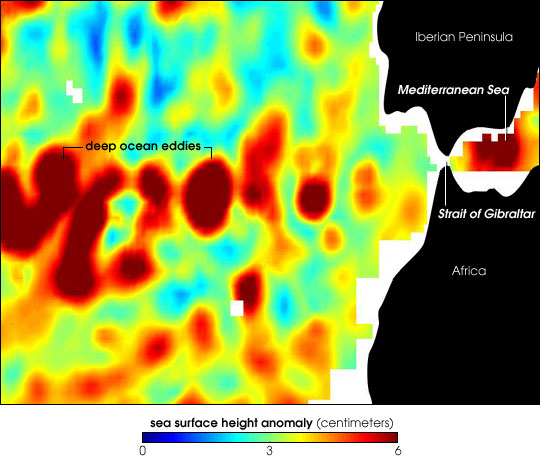
Satellites Detect Deep-Ocean Whirlpools

Click here to view full image (190 kb)


Submerged in the Atlantic Ocean off the coast of Spain and Portugal are
giant, salty whirlpools of warm water. These deep-water whirlpools are part
of the oceans circulatory system, and they help drive the ocean currents
that moderate Earth's climate. Warm water ordinarily sits at the ocean's
surface, but the warm water flowing out of the Mediterranean Sea is so salty
(and therefore dense) that when it enters the Atlantic Ocean at the Strait
of Gibraltar, it sinks to depths of more than 1,000 meters (one-half mile)
along the continental shelf. This underwater river then separates into
clockwise-flowing eddies that may continue to spin westward for more than
two years, often coalescing with other eddies to form giant, salty
whirlpools that may stretch for hundreds of miles. Because the eddies
originate from the Mediterranean Sea, scientists call them "Meddies".
Although Meddies are submerged beneath hundreds of meters of water, scientists recently developed a technique to detect Meddies from space by measuring changes in sea surface height. The warm water of the Meddies causes the ocean to expand where they are, which raises the height of the sea surface above them. This image shows where the Meddies (deep red areas) bumped up the sea surface height in 2005, as compared to the average annual conditions from 1993-2005. The Meddies produced anomalies of as much as 6 centimeters above average heights, spreading across the Atlantic to the west of the Strait of Gibraltar. While some Meddies appear isolated, others seem to be merging. Areas for which there were no data are colored white.
Scientists mapped the location of Meddies using satellite-based altimeters to measure sea surface height, specialized microwave radars to account for surface wind speed (which can also influence sea height), and radiometers to observe infrared (heat) energy emitted from the ocean surface. This Meddy-mapping technique was developed by scientists from NASAs Jet Propulsion Laboratory, the University of Delaware, and the Ocean University of China. To read more about the project, please read Scientists Use Satellites to Help Detect Deep-Ocean Whirlpools.
Image courtesy University of Delaware College of Marine Studies/Center for Remote Sensing. Text adapted from the NASA-JPL press release.
<=== Post-doc. research in Dundee page
 Jos van Geffen --
Home |
Site Map |
Contact Me
Jos van Geffen --
Home |
Site Map |
Contact Me